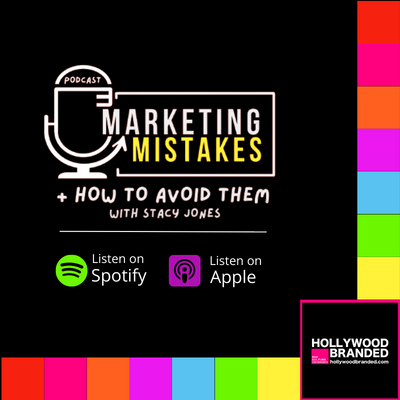The Importance Of Data In Your Company Tools
Table Of Contents
Don't Forget to Define!
Running a business can feel wildly daunting, and having to constantly wear multiple hats to keep your company afloat can seem impossible. That's where JJ Reynolds, the head of marketing and analytics at Media Authentic, comes in. He specializes in helping brands fully collect and understand data from their customers to best increase their sales.
Data is often overlooked, despite being the most trusted source of information regarding your customers. In this blog, Hollywood Branded shares the importance of utilizing data within your company and how it can help your brand increase its' revenue.

A Little More About JJ
JJ works in marketing analytics at MediaAuthentic, he focuses on assisting businesses in measuring and acting on their marketing data. With his team, they take all of their client's data from their CRM, Google Analytics, and cart platform, then turn it into a real-time data dashboard for you to take action. JJ understands that being online takes a lot of work and helps eliminate the “guesswork."
Interview Transcript Highlights
Question: How did you get to where you are today? Most people don't wake up in the morning in love with everything about digital marketing, but you do! Tell us about that.
Answer: I actually started out in the world of Google Ads. Right out of college, I hopped into working with Google Ads at an agency. I learned all about solar ads, direct response ads, and all those different types of nuances and niches. We were spending, I think on average, between forty and one hundred thousand dollars a month with our clients; they were some pretty significant spends for average businesses.
The recurring question that we kept getting, from clients of every size, is, "Is it working?" I ended up going out on my own; I actually dabbled in the world of Facebook ads, as well. And, I found myself also coming back to the question of "is it working?" I ended up taking a lot of different classes and watching different tutorials, just trying to drill into the question, fully. I learned all of the tools around websites, CRMs, and ad platforms, and ended up stopping running ads altogether. We built out an entire team that only works to answer the question, "is it working?"
Question: Where do you find some of the issues happening along the way when working with clients?
Answer: The biggest issue I find is asking the wrong questions, and I'll give you a great example of that. In short, ask the best possible question you can; don't worry about how you'll get the answer. Someone like myself and my team will have to figure out how to get the answer to that question. If you did your job right, you asked an incredible question that has an incredible action that could be taken upon finding the answer. Issues arise when people ask questions that aren't actionable. My favorite question, if you sell widgets, is to ask "Do sales increase when the weather is bad?" 9 times out of t10, we can find this information. We could pull the APIs or the weather at that particular hour in that particular city that your sale came from. We could find how many users were in the city, how much it was raining, and all that jazz. We could find that your brand sells 90% more product when it rains, and if you could figure out how to make it rain, it's a great business model. But what are you really going to do with that information since you can't control the weather? Almost nothing. Again, the best way to stay on track is to ask the best possible questions that you can take action on.
Question: So, you're getting the answers as to how you can take your next action and move forward. Are there any specific areas that you see come up more often than not?
Answer: If you have a website, you need to ask yourself why you have a website. Decide what the purpose of the website is, in general, and then decide what the purpose of each section of your website is. That's the biggest overall piece, but everyone builds something different. For example, about four years ago, chatbots were all the craze. you couldn't go anywhere without hearing about tons of chatbots on sites or Facebook chatbots. Real people had to build these, but where are they now? A lot of people abandoned them, but there are some people that still have and use them. I think the big problem with them was that people didn't really think about the purpose of having them. If they stopped serving their purpose, stop using them.
With every aspect of your business, you have to ask yourself WHY. Why are you recording a podcast? Why are you writing a blog post? Why are you making a YouTube video? Why do you have a website? Decide the task's purpose and then see what it is doing to achieve that purpose. If it's not achieving anything, let's either improve it or stop it altogether. The feedback loop is basically what we're trying to build. You do an action, you see the results, and you figure out if those are the results that you wanted. We come in when you want to shorten that feedback loop. We can have reports for you in real-time. Weekly reporting can be super helpful, and the shorter you can get your feedback loop, the better off you'll be. You can then take action as fast as your team can act.
Question: What are some additional issues that you see popping up for brand marketers?
Answer: A big thing is not knowing why a number exists. But another big one that I find coming through is "what is a user on a website?" People don't entirely know how to define a user. A definition on the internet is quite fluid; different people can define users in vastly different ways. At a company, you need to have a conversation about how to define all of the big buzzwords that people love to use.
For example, bounce rate is something that almost everyone has heard of. Some people are just familiar with the word, some people have a general idea of what it is, but very few actually know what it means. The best thing to fully understand your bounce rate is to define it before you look in-depth at it, because once you define it, the data can change.
The technical definition of a bounce rate is if there is no second event or action. For example, if you have a page view, all you're measuring is page views. Someone could come to your page and want to see more, but if there isn't a second-page view, then you're constantly getting bounces. This person could have spent five or ten minutes on your site reading articles you wrote, but if they didn't click on anything else to get to this page, analytics just read this as a bounce; they just see the user as simply loading the page. You could have the most engaged readers out there, but if you on;y have one page with all of your content, you'll only get bounces. This is why it's so important to define bounce rates or really any other important term for your success; without defining it, you won't know how it's measured.
Question: What are some things that people on the brand team tend to deviate from or get confused by?
Answer: I think one of the biggest things is measuring onsite and offsite metrics. Onsite metrics are your websites. Offsite metrics are really anything that's off of your website: YouTube video views, Facebook impressions, or direct mail sends. Most people will look at these and say that they're going to count everything with equal weight; if they saw your Instagram post, they have the opportunity to buy, so that'll be counted in the marketing funnel. Other people will only count its if they actually go to the website, and that's all they'll look at. The real answer is that it's somewhere in between. If you can have a good idea of what your off-platform strategy is, you have to figure out the full intention. Are you a company that wants to go after users on YouTube? Would it be beneficial to post a video every week? What is the intention of your videos? Is the intention to sell? To be educational? To drive leads? Why are you making YouTube videos? Defining the offsite and onsite strategies can be really advantageous to look at, separately, as silos. Once you've looked at them separately, look at them together to see how they influence each other.
Check Out The Podcast!
JJ has so much great information from his experience in collecting and understanding data to improve your company's success. Check out the podcast below to learn more about data collection!
Every week we have a marketing professional on our show to share their tips, tricks and lessons learned from their professional experience. Check out some of our other podcast blogs from earlier this year:
- The Best Way For Companies To Scale Your Business To 6 Figures And Beyond
- How To Best Measure and Track Behaviors to Drive Sales
- How To Gain the Highest ROI
- Build Your Brand Around Your Best Customers
- Manage Your Media Strategy With An Ever-Changing Climate
Every week we release a new podcast featuring guests with so much knowledge about marketing, you don't want to miss one! How can you make sure you don't miss an episode? Click below to subscribe!








